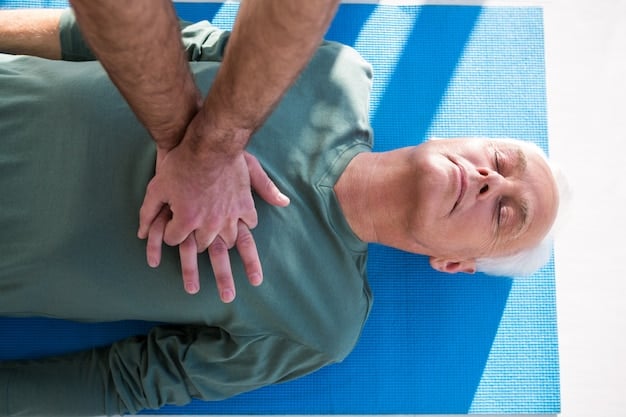This Simple CPR Trick Could Save a Child's Life - You Know It?
 In moments of crisis, the ability to act swiftly and effectively can mean the difference between life and death, especially when it comes to our most vulnerable population-children. Cardiopulmonary resuscitation (CPR) is a critical skill that every parent, caregiver, and responsible adult should master. Unlike adults, children and infants have unique physiological needs that require tailored techniques for resuscitation.
In moments of crisis, the ability to act swiftly and effectively can mean the difference between life and death, especially when it comes to our most vulnerable population-children. Cardiopulmonary resuscitation (CPR) is a critical skill that every parent, caregiver, and responsible adult should master. Unlike adults, children and infants have unique physiological needs that require tailored techniques for resuscitation.
Child CPR Techniques
Here are the key techniques for performing CPR on children:
-
Assess the Situation:
- Ensure the environment is #safe for both you and the child.
- Check for responsiveness by gently shaking the child and shouting, "Are you okay?"
-
Call for Help:
- If the child is unresponsive, call #emergency services immediately or ask someone else to do so while you attend to the child.
-
Check for Breathing:
- Look for chest movements, listen for breath sounds, and feel for breath on your cheek.
- If the child is not breathing or only gasping, begin CPR.
-
Positioning:
- Place the child on a firm, flat surface.
- For infants (under 1 year), use a soft surface like a changing table or floor.
-
Chest Compressions:
- For children aged 1 to puberty, use one or two hands (depending on the size of the child) to compress the chest at least 2 inches deep at a rate of 100-120 compressions per minute.
- For infants, use two fingers placed just below the nipple line and compress about 1.5 inches deep.
-
Rescue Breaths:
- After every 30 compressions, give 2 rescue breaths.
- For children, seal your lips around their mouth and nose, and give gentle breaths until you see the chest rise.
- For infants, cover their mouth and nose with your mouth and give gentle puffs.
-
Continue the Cycle:
- Alternate between 30 chest compressions and 2 rescue breaths until emergency help arrives or the child shows signs of life.
-
Use an AED if Available:
- If an Automated External Defibrillator (AED) is available, turn it on and follow the voice prompts. Use pediatric pads if available.
-
Stay Calm and Focused:
- Keep your composure to effectively perform CPR and reassure any bystanders or family members.
Infant CPR Guidelines
Steps to Perform CPR on Infants
-
Assess the Situation:
- Danger: Ensure the area is safe for both you and the infant. Remove any potential hazards to prevent further injury.
- Response: Check for a response by gently tapping the infant's shoulder or calling out loudly. Avoid shaking the infant.
-
Call for Help:
- If there is no response, immediately call emergency services or ask someone else to make the call. Do not leave the infant alone.
-
Check the Airway:
- Open the infant's mouth and look for any obstructions such as vomit or foreign objects.
- If there are blockages, place the infant face down on your forearm with their mouth slightly downward and support their head. Use your little finger to remove any visible obstructions.
- After clearing the airway, gently tilt the infant's head back to a neutral position (head and neck in line).
-
Assess Breathing:
- Look for movement in the infant's chest or abdomen, listen for breathing sounds, and feel for air escaping from their mouth and nose.
- If the infant is not breathing normally, place them on their back on a firm surface while keeping their head in a neutral position.
-
Perform CPR:
- If the infant is not breathing, begin CPR immediately. The key components include:
- Chest Compressions:
- Place the infant on their back on a firm surface.
- Locate the lower half of the breastbone in the center of the chest.
- Use two fingers to compress the chest by about one-third of its depth.
- Perform 30 compressions at a rate of 100 to 120 compressions per minute.
- Rescue Breaths:
- Tilt the infant's head back slightly and lift the chin.
- Cover the infant's mouth and nose with your mouth to create a seal.
- Give 2 gentle breaths, each lasting about 1 second, watching for the chest to rise.
- Chest Compressions:
- If the infant is not breathing, begin CPR immediately. The key components include:
-
Continue CPR:
- Repeat the cycle of 30 chest compressions followed by 2 breaths until:
- The infant shows signs of recovery (breathing, coughing, or moving).
- You are too exhausted to continue.
- Emergency services arrive and take over.
- Repeat the cycle of 30 chest compressions followed by 2 breaths until:
Important Considerations
- Always ensure that the infant is on a firm, flat surface during CPR.
- If you are alone, perform CPR for about 2 minutes before calling for help if you haven't done so already.
- If an Automated External Defibrillator (AED) is available, use it as soon as possible, following the device's instructions.
The significance of CPR training can be summarized as follows:
-
Life-Saving Skills: CPR training provides individuals with the essential skills needed to perform cardiopulmonary resuscitation effectively. This knowledge can be the difference between life and death in emergencies, particularly for children who may experience cardiac or breathing emergencies.
-
Increased Confidence: Understanding how to perform CPR instills confidence in caregivers and #parents. This confidence is crucial during high- #stress situations, enabling them to act quickly and efficiently without hesitation.
-
Empowerment: CPR training empowers individuals to take action when they witness someone in distress. It transforms bystanders into potential lifesavers, creating a community that is prepared to respond to emergencies.
-
Community Preparedness: Widespread CPR training fosters a #culture of #safety within communities. When more people are trained, the likelihood of a timely response to emergencies increases, leading to better outcomes for victims.
-
Adaptability Across Age Groups: CPR techniques vary depending on the age of the victim (adult, child, or infant). Training ensures that caregivers understand these differences and can apply the appropriate techniques based on the situation.
-
Ongoing Education: CPR training is not a one-time event. Regular refreshers and updates on the latest guidelines ensure that individuals remain knowledgeable and prepared to respond effectively.
References
- https://www.redcross.org/take-a-class/ #cpr/performing-cpr/child-baby-cpr?srsltid=AfmBOopMXmGXY3Grkif6HpkmNHXlYwQUT3gxjnmuAODyRdVwvihU8GdX
- https://www.pinterest.com/pin/61854194871777870/
- https://www.healthdirect.gov.au/how-to-perform-cpr
- https://avive.life/blog/differences-infant-child-adult-cpr/
- https://www.quora.com/What-are-the-steps-for-performing-CPR-on-an-adult-and-a-child-Can-you-provide-some-examples-of-situations-where-this-skill-would-be-necessary
- https://www.youtube.com/watch?v=8aZnwUp1cdY
- https://www.healthdirect.gov.au/how-to-perform-cpr
- https://www.quora.com/How-do-you-know-whether-or-not-to-do-child-CPR-or-adult-CPR-if-the-patient-is-12
- https://www.youtube.com/watch?v=NyvNGnKjKDw&pp=ygULI2Jha3Nvc2JsczM%3D
- https://www.youtube.com/watch?v=-NodDRTsV88
- https://www.youtube.com/watch?v=ePodw7L_mFM
- https://www.pinterest.com/pin/pinterest--141511613278540518/
- CPR & AED Adult, Child, Infant - In Person
- CPR & AED Adult, Child, Infant - Blended
- Pediatric RSV First Aid & CPR/AED
- Potty Training Made Simple
- Basic Health & Safety and Breastfeeding Awareness
- Adult Only CPR AED and Adult First Aid Blended
- Basic Life Support (BLS) In-Person Healthcare Providers
- Basic Life Support (BLS) Blended Healthcare Providers
- 10 Reasons this Summer to Take Pediatric First Aid and CPR with ChildCareEd
- Learn CPR and Be the Hero in a Crisis!!
- This Simple CPR Trick Could Save a Child's Life - You Know It?
- These Adult and Pediatric CPR Facts Will Shock You!
- When Seconds Count: Real-Life Cases Where Health & Safety Training Saved Lives


